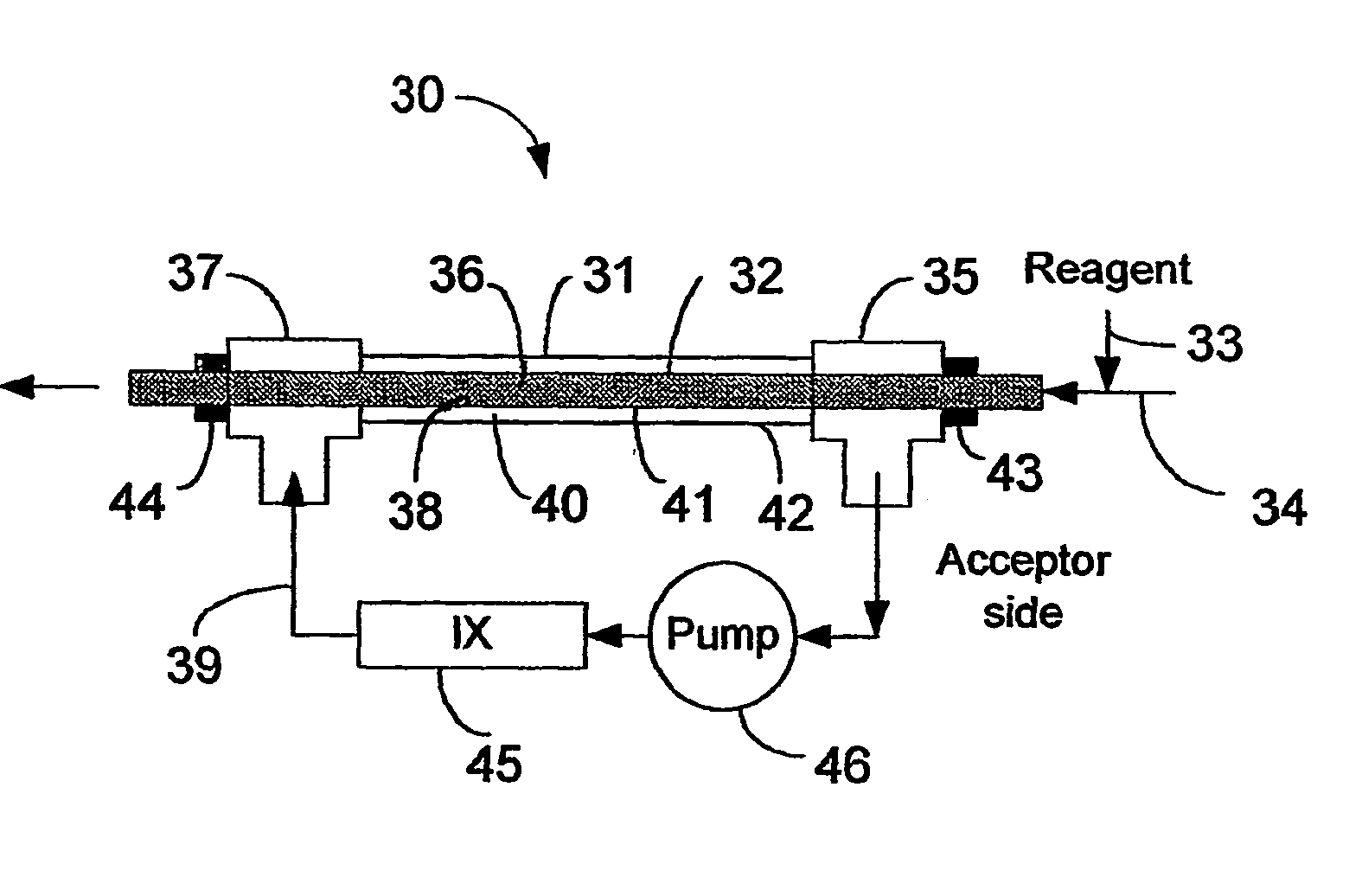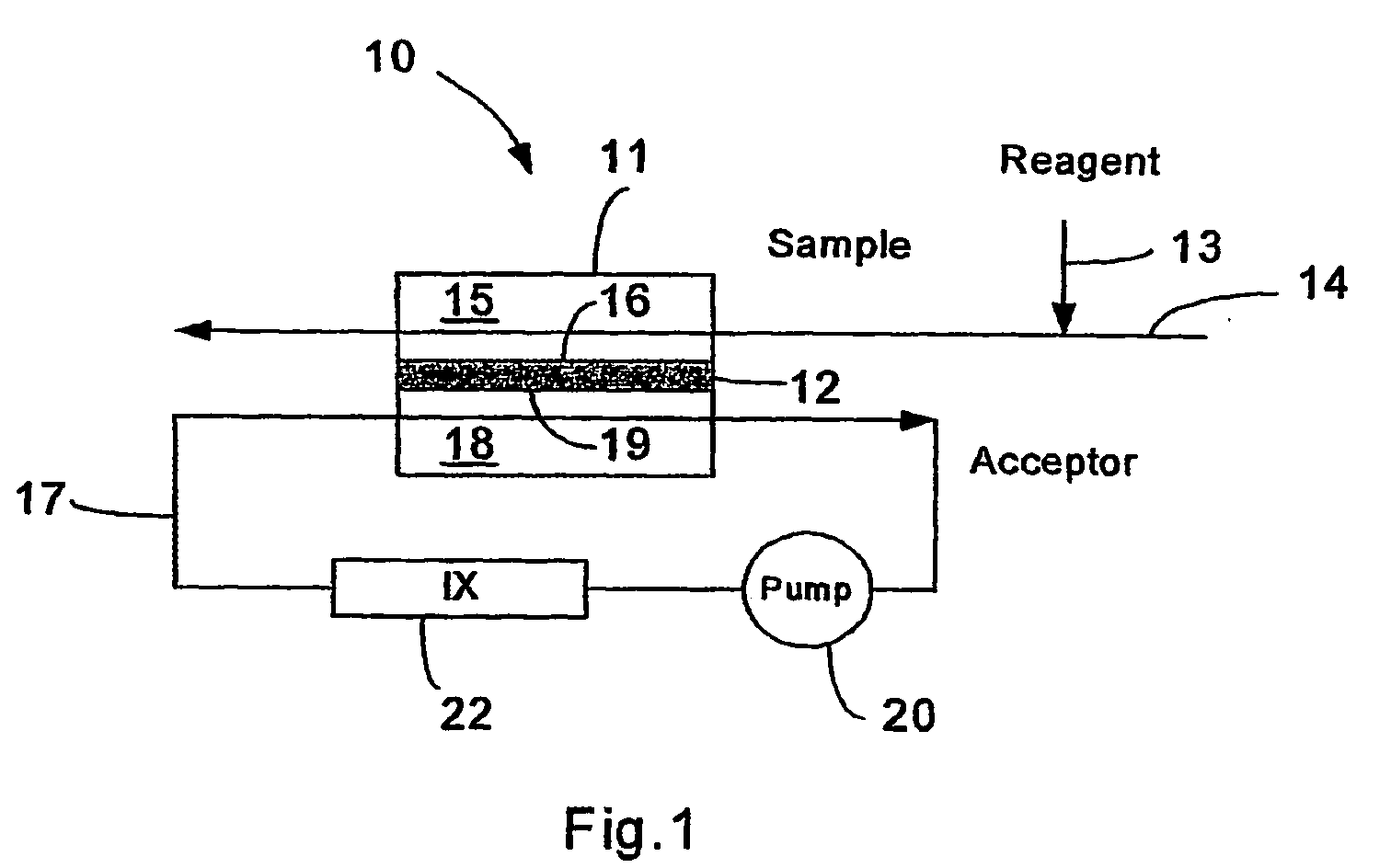Inorganic carbon removal
a technology of inorganic carbon and removal, applied in the field of inorganic carbon removal, can solve the problems of adverse effects on the accuracy of tc and ic measurements, and it is impossible to precisely determine the concentration of toc from the small difference between the large tc and ic concentration, so as to minimize the removal or loss of volatile organic compounds
- Summary
- Abstract
- Description
- Claims
- Application Information
AI Technical Summary
Benefits of technology
Problems solved by technology
Method used
Image
Examples
example 1
[0059] The following tests were performed to demonstrate the practice and efficiency of this invention in the removal of a volatile electrolyte, such as carbon dioxide, from an aqueous sample at varying temperatures.
[0060] A tubular design gas transfer module similar to that illustrated in FIG. 2 was used in this example. Carbon dioxide, at a concentration of 28 ppm C in water, was passed through the inside of a tubular Teflon AF membrane. The temperature was changed by heating the acceptor stream, which was deionized water.
[0061] The results are illustrated in FIG. 4 which plots IC removal efficiency against residence time of the sample in the IC transfer unit at three temperatures, 30° C., 50° C. and 70° C. FIG. 4 shows that, at each temperature, essentially 100% removal of IC from the sample fluid was achieved in under three minutes (less than 180 seconds).
example 2
[0062] Another set of experiments was performed using an IC transfer module containing a flat or planar PFA membrane similar to the membrane configuration illustrated in FIG. 1. For this set of experiments, the sample residence time in the IC transfer module was changed by varying the sample flow rate. The results are shown in FIG. 5 which plots IC removal efficiency against residence time of the sample in the IC transfer unit at three concentrations of C and IC in the sample, 5 ppm C, 25 ppm C and 50 ppm C. FIG. 5 shows that removal efficiency for any given residence time does not vary significantly with IC concentration over a broad range.
example 3
[0063] In general, a solution containing a volatile organic compound will lose a very small amount of this compound while going through the IC module of the present invention. However, the amount that is lost in this way can be minimized through the choice of the membrane material and by minimizing the sample residence time.
[0064] In this example, two different membranes were tested for IC removal in accordance with the present invention. The concentration of various volatile organic compounds in an aqueous sample stream was determined before and after the sample was passed through each of two IC transfer units according to the present invention, one such unit utilizing a Teflon AF membrane, the other utilizing a Gortex membrane. In addition, the sample stream was tested for IC (as CO2) concentration both before and after passing through each of the two IC transfer units. A relatively short residence time of 15 seconds in the IC transfer units was used for these tests.
[0065] The r...
PUM
| Property | Measurement | Unit |
|---|---|---|
| temperature | aaaaa | aaaaa |
| temperature | aaaaa | aaaaa |
| temperature | aaaaa | aaaaa |
Abstract
Description
Claims
Application Information
 Login to View More
Login to View More - R&D
- Intellectual Property
- Life Sciences
- Materials
- Tech Scout
- Unparalleled Data Quality
- Higher Quality Content
- 60% Fewer Hallucinations
Browse by: Latest US Patents, China's latest patents, Technical Efficacy Thesaurus, Application Domain, Technology Topic, Popular Technical Reports.
© 2025 PatSnap. All rights reserved.Legal|Privacy policy|Modern Slavery Act Transparency Statement|Sitemap|About US| Contact US: help@patsnap.com



